
This is a 50 minute lesson where preschool to kindergarten-aged students explore using their five senses several different station of materials
- Material Type:
- Activity/Lab
- Date Added:
- 09/09/2012

This is a 50 minute lesson where preschool to kindergarten-aged students explore using their five senses several different station of materials
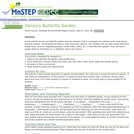
This is an activity in which students use their senses to describe their garden. This is a guided inquiry lesson.
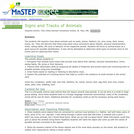
Students will examine clues about animals such as nests, leaves, feathers, fur, tracks that allow some conclusions about the identity, physical characteristics or behavior of the animals. Students will study the characteristics of animal tracks.

The purpose of this resource is to investigate the center pixel of a homogeneous land Cover Site in order to understand that individual land areas are part of a larger land system.

This inquiry lab activity involves students working to understand that sound is made from vibrations.
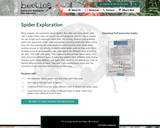
Many students are squeamish about spiders. But when you spray spider webs with a water mister, they are easy to see and gorgeous, and just about anyone can get caught up in exploring them! After this activity, students will probably notice and appreciate spider webs everywhere, including when they return home. They will also probably be more careful to avoid knocking webs down while walking around. In this activity, students notice spider webs as they walk. When students arrive at an exploration site, pairs search for different kinds of webs in the area, mist them with water, then regroup to discuss their observations and think about how different types of webs help spiders catch different kinds of prey. Students learn about different web types, then return to the field to use a key to identify different kinds of webs. They also make explanations about how the structures of the webs they find function to catch prey.
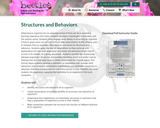
Observing an organism for an extended period of time can be a rewarding learning experience that helps students develop a meaningful relationship with the natural world. Students often engage more deeply in observing an organism if they’re given some sort of task to focus their observations. In this activity, pairs of students find an organism, then observe and record its structures and behaviors. Students apply the lens of adaptations as they come up with explanations for how their organisms’ structures and behaviors might help it survive in its habitat. In a group discussion, students consider the relationship between organisms’ structures and possible functions, which is a useful science thinking tool that can help them to better understand the natural world. This activity helps students develop a definition of adaptation that includes both behavioral and structural adaptations (adaptations are inheritable structures or behaviors that help a population of organisms survive in their habitat), and gives students the experience applying that definition to an organism in the local ecosystem.

This course explores the diverse ways that people teach and learn—in different countries, in different disciplines, and in different subcultures. We will discuss how theories of learning can be applied to a variety of hands-on, in-class learning activities. We compare schooling to other forms of knowledge transmission from initiation and apprenticeship to recent innovations in online education such as MOOCs. Students will employ a range of qualitative methods in conducting original research on topics of their choice.

Let's practice thinking like a scientist! Check out the video from Dr. Tavis Forrester, Research Wildlife Biologist for the Oregon Department of Fish and Wildlife. Then, in the Discovery Challenge video, we'll unlock mysteries that surround us by using the 3 I's of Scientist - I Notice, I Wonder, It Reminds Me Of. Lesson Credit: BEETLESproject.org.
This lesson introduces NGSS standards, and those standards are listed in the lesson.
Videos are part of the Explore Science Club series, an asynchronous online learning program using YouTube videos that connects elementary and middle school students to STEM professionals through hands-on lessons where students explore science and engineering practices related to the highlighted careers. There is an option to use FlipGrid, an online video recording platform for students to share their discoveries

Students will create a panorama drawing of their own landscape. They will include landmarks and cardinal directions in their drawings, and use their drawings to plot the movement of the sun in the sky over the course of a day. They may make their observations in one day, or over a period of days or weeks. Once students have created their own panoramas, they will look at panoramas taken in the North and South Poles and compare similarities and differences. They will then explore the “Sun Path Simulator” online. Before beginning these lessons, students should already know: 1) How to find the four, cardinal directions, and 2) That the Earth rotates on its axis, and revolves around the sun. 3) How to tell time. This unit pairs nicely with the Mystery Science Unit, Spinning Sky. Where indicated, worksheets and videos for lessons can be found on their website. Links to all other worksheets for the entire unit are in the “Overview” Section of my slideshow. Each day’s lesson comes with a worksheet to focus the students and to show evidence of student learning.

This article provides ideas and lessons on how elementary teachers can integrate webcams from the Arctic and Antarctica into their teaching. Five webcams are highlighted as well as three lessons on writing poetry and observing animal behavior.
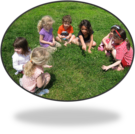
Incorporating your schoolyard into your classroom can be a powerful tool for making learning meaningful and engaging for your students. Local and relevant phenomena can engage your student’s prior understandings, better connect to their interests and identities, and help in draw in students who don’t see science, reading or writing connecting to their lives. This online course is a series of professional development workshops for Early Elementary (K-2) educators, developed by IslandWood with funding from the OSPI ClimeTime Grant. A slide deck and accompanying handouts supplement the course outline for a complete picture.
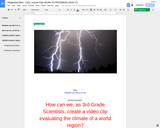
Learning Goals/Outcomes/Objectives:
Observable features of the student performance by the end of the grade: 1). Obtaining information: Students use books and other reliable media to gather information about: i. Climates in different regions of the world (e.g., equatorial, polar, coastal, mid-continental). ii. Variations in climates within different regions of the world (e.g., variations could include an area’s average temperatures and precipitation during various months over several years or an area’s average rainfall and temperatures during the rainy season over several years). 2 Evaluating information a Student's combine obtained information to provide evidence about the climate pattern in a region that can be used to make predictions about typical weather conditions in that region. 3 Communicating information a Students use the information they obtained and combined to describe*: i. Climates in different regions of the world. ii. Examples of how patterns in climate could be used to predict typical weather conditions. iii. That climate can vary over years in different regions of the world.
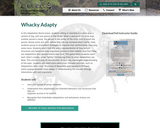
In this Adaptation Name Game, students sitting or standing in a circle play a version of tag, with one person in the center. When a person in the circle says another person’s name, the person in the center of the circle tries to touch the person whose name was said, before they can say someone else’s name. Later, students pause to brainstorm strategies to improve their performance, then play some more. Students learn that this was a representation of how certain structures and behaviors help organisms survive in their habitat, and that these are adaptations that species inherit over time. This game helps students learn each other’s names, while “lightly” introducing them to what adaptations are. Note: This activity is only an introduction; to gain any meaningful understanding of the topic, students will need more adaptation-focused activities, such as Adaptations Intro-Live!, Structures & Behaviors, and Related & Different, which engage students more deeply in understanding the concept through interactions with real organisms.
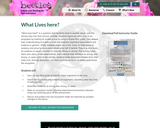
“What lives here?” is a question that students tend to wonder about, and this activity taps into that natural curiosity. Students figure out what lives in an ecosystem by looking for evidence and by using a simple field guide. They deepen their understanding of evidence, both the evidence organisms leave behind and evidence in general. Often, students might see a hair, track, or other piece of evidence and jump to conclusions about what left it behind. They may also treat all evidence as equal, whether it’s actually flimsy or strong. This activity helps them slow down, make observations, and evaluate their evidence as strong, less strong, or weak. Later in the activity, students make ecosystem models from their notes and, through discussion, use them as evidence to try to better understand the ecosystem.
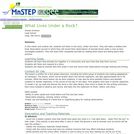
Students will listen to the book, Under One Rock Bugs, Slugs, and Other Ughs, written by Anthony D. Frederick and illustrated by Jennifer DiRubbio and then make a mini-book observation journal, Under One Rock to record what they see when they go outdoors to investigate what lives under a rock.
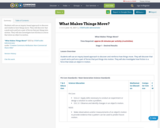
Students will use an inquiry based approach to discover and reinforce how things move. They will discover that a push and a pull are a pair of forces that put things into motion. They will also investigate how friction is a force that slows an object in motion.
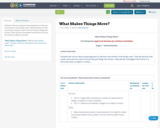
Students will use an inquiry based approach to discover and reinforce how things move. They will discover that a push and a pull are a pair of forces that put things into motion. They will also investigate how friction is a force that slows an object in motion.
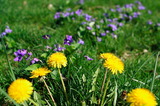
This professional development course consists of a series of workshops focused on NGSS-aligned & local phenomenon-centered curriculum, developed by IslandWood with funding from the OSPI ClimeTime Grant. It is currently structured to be delivered online and for Upper Elementary (3-5) educators. A slide deck and accompanying handouts are available to complement the course outline.

This course focuses on a number of qualitative social science methods that can be productively used in media studies research including interviewing, participant observation, focus groups, cultural probes, visual sociology, and ethnography. The emphasis will primarily be on understanding and learning concrete techniques that can be evaluated for their usefulness in any given project and utilized as needed. Data organization and analysis will be addressed. Several advanced critical thematics will also be covered, including ethics, reciprocity, "studying up," and risk. The course will be taught via a combination of lectures, class discussions, group exercises, and assignments. This course requires a willingness to work hands-on with learning various social science methods and a commitment to the preparation for such (including reading, discussion, and reflection).